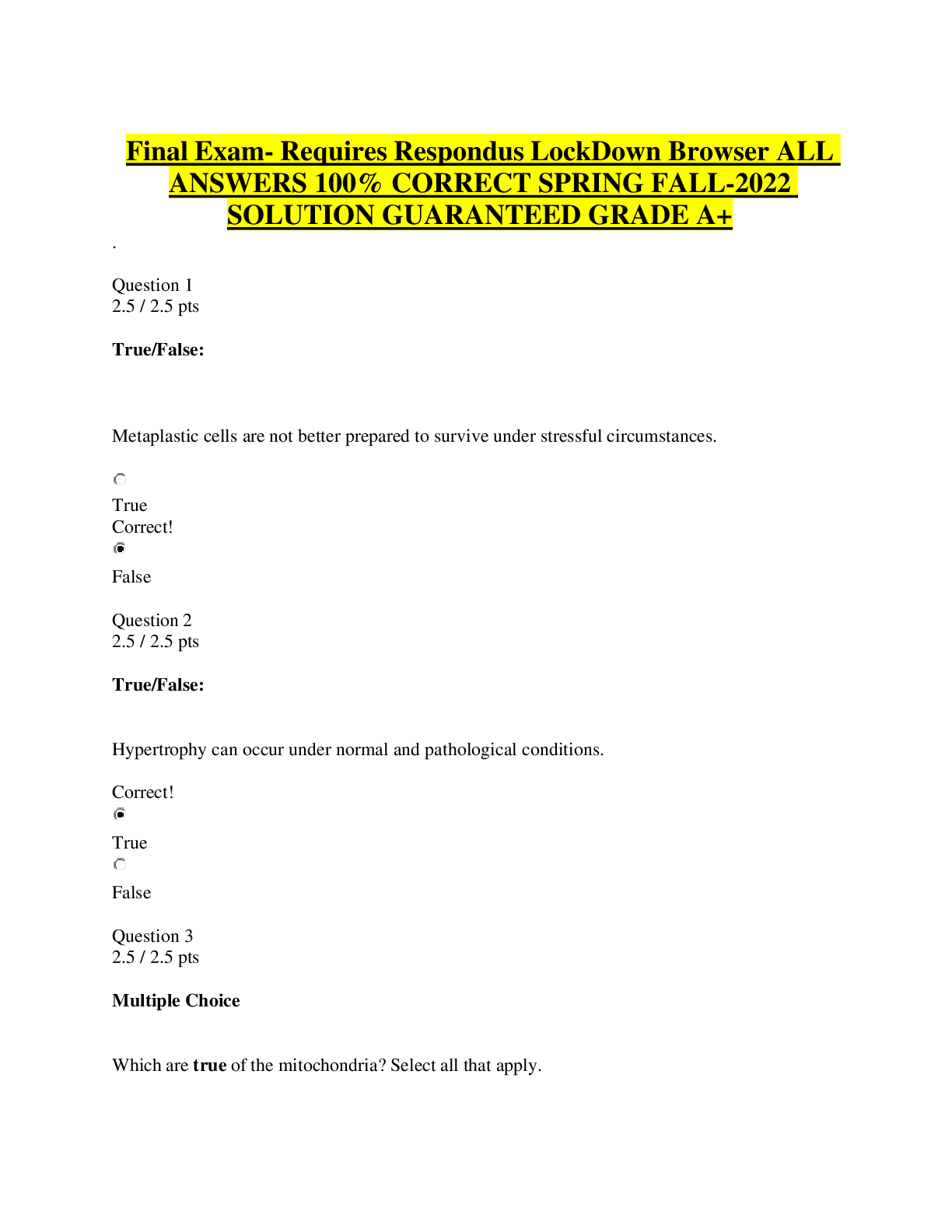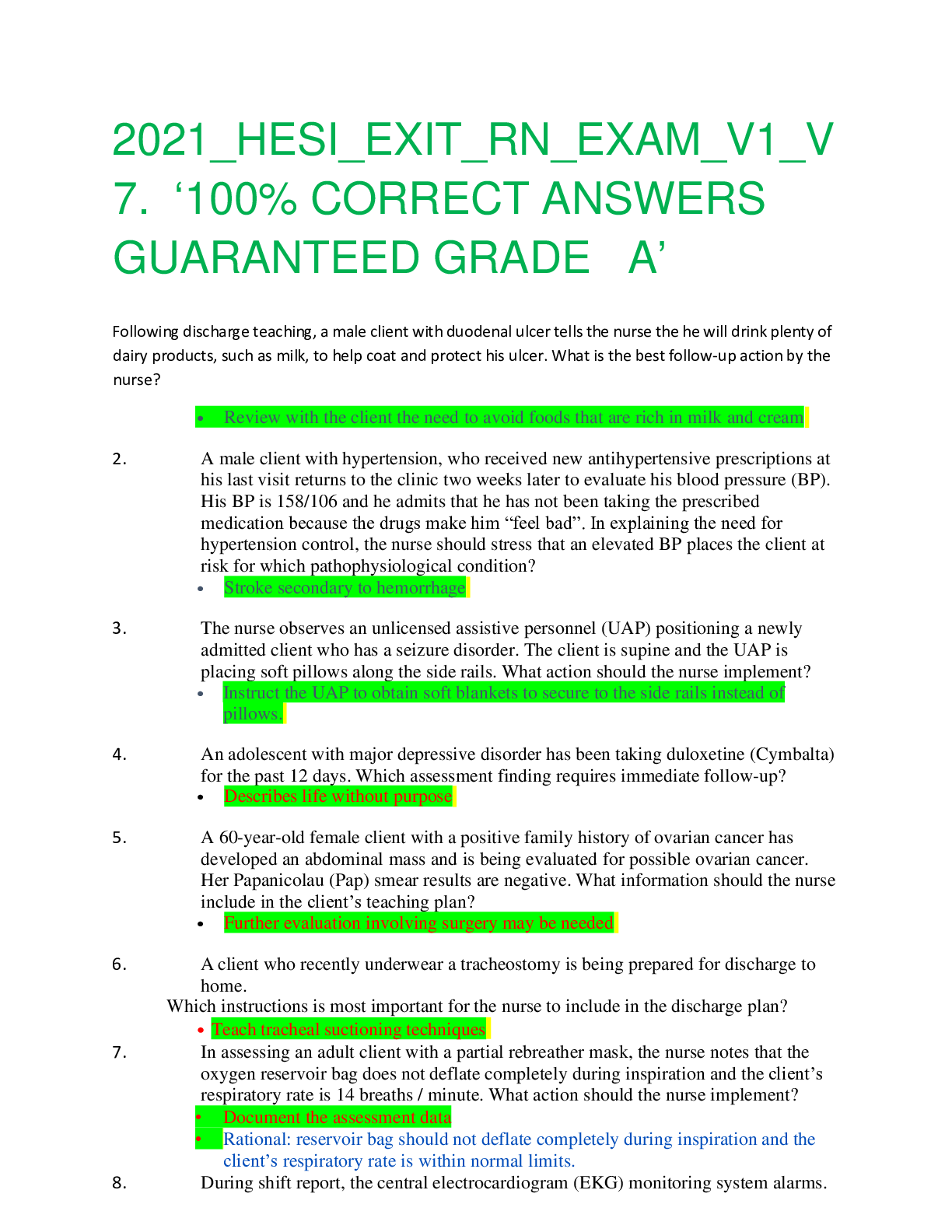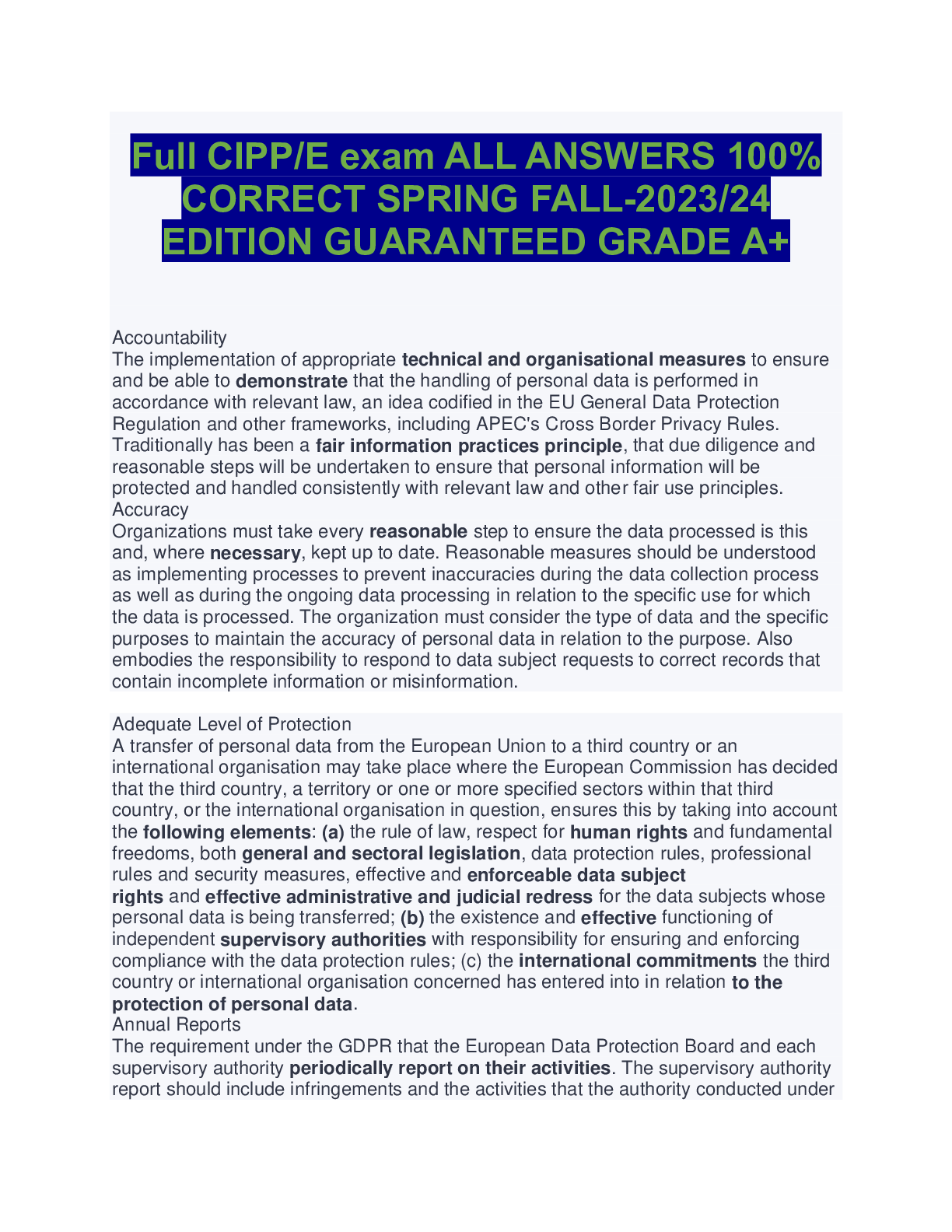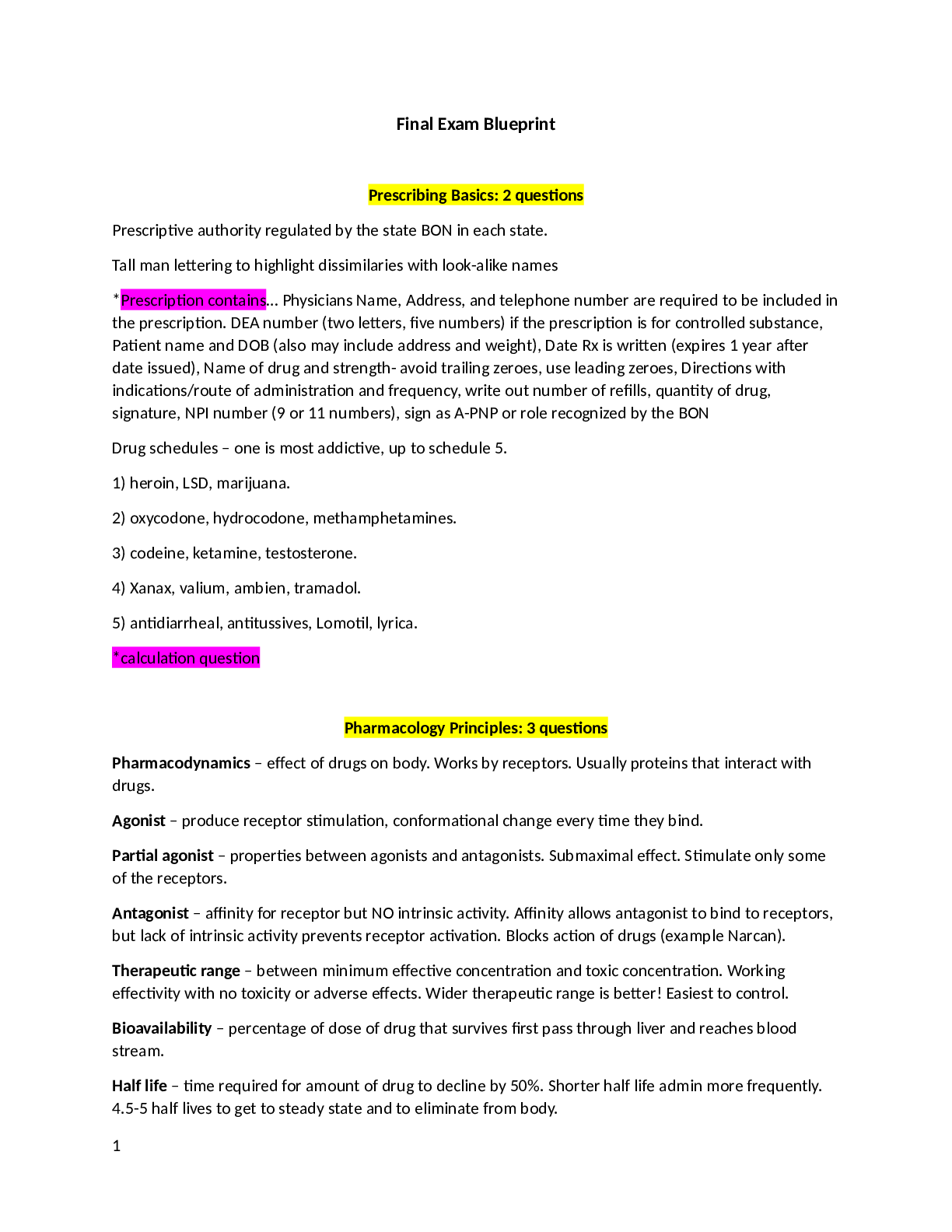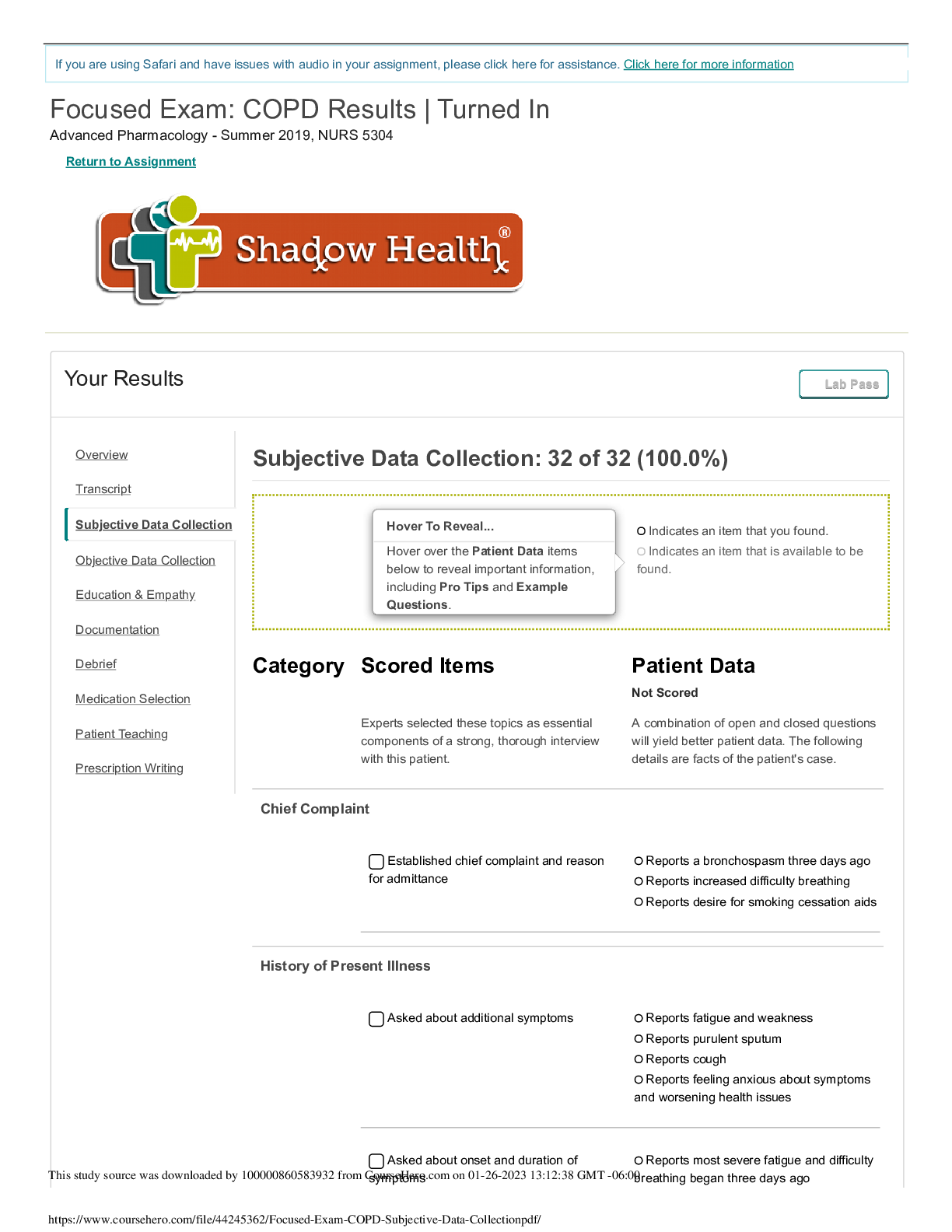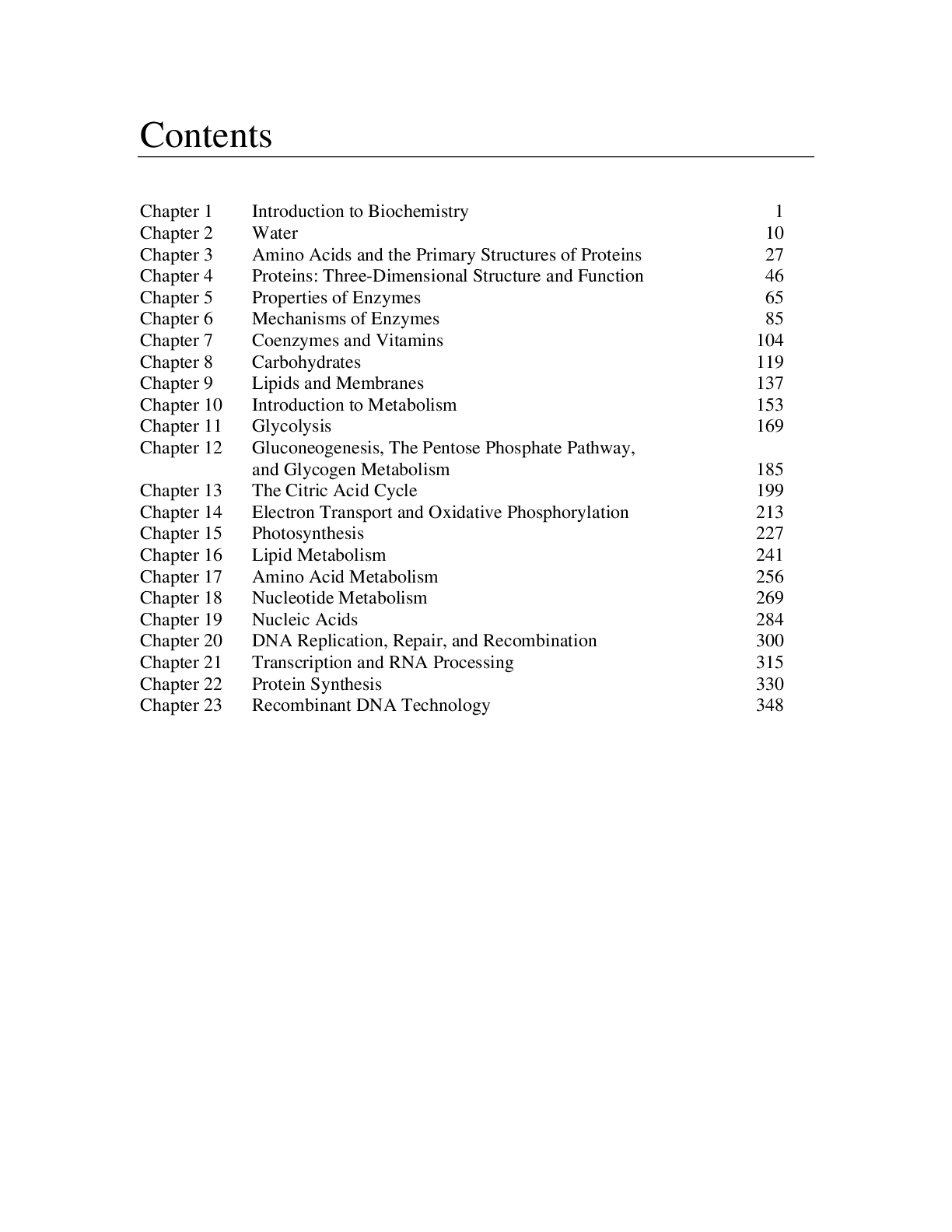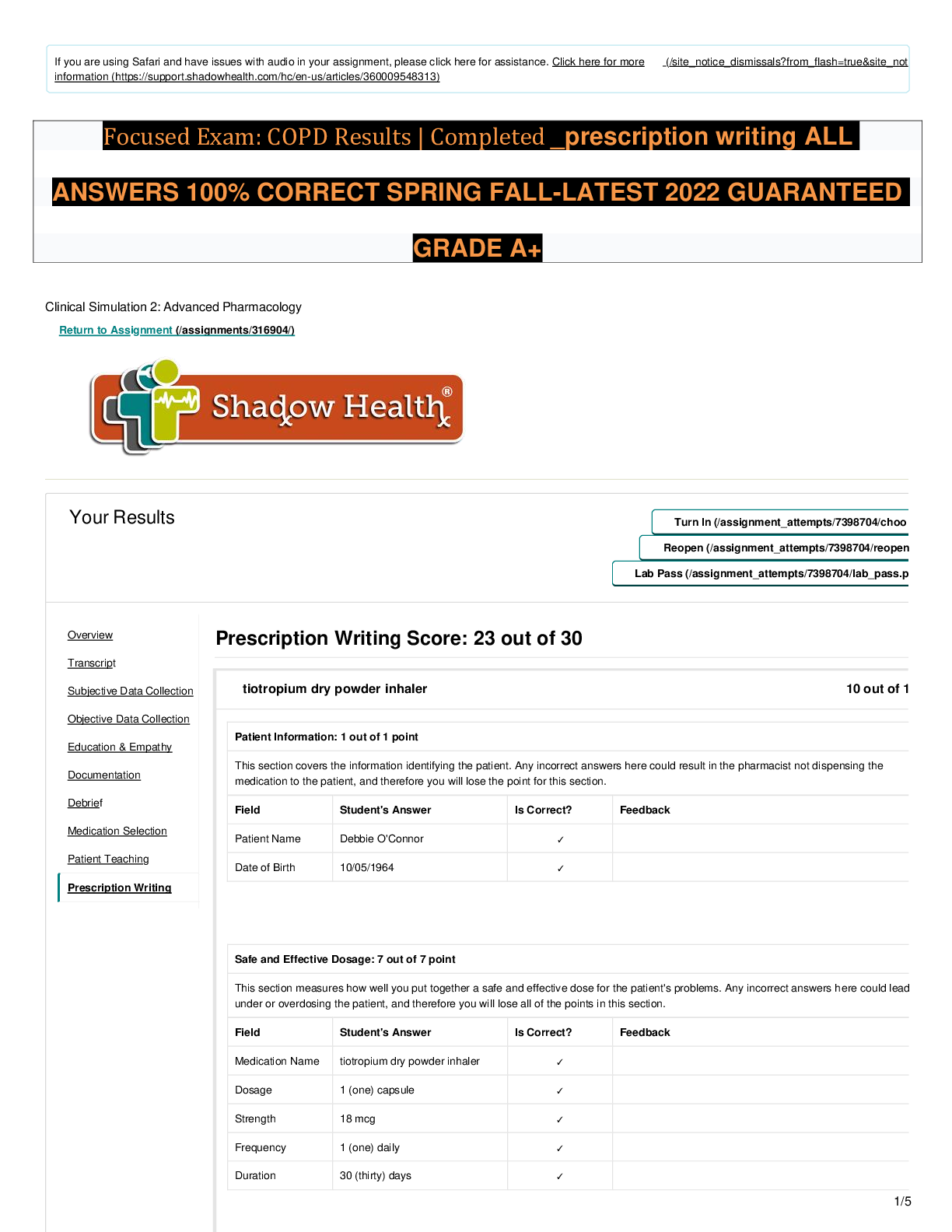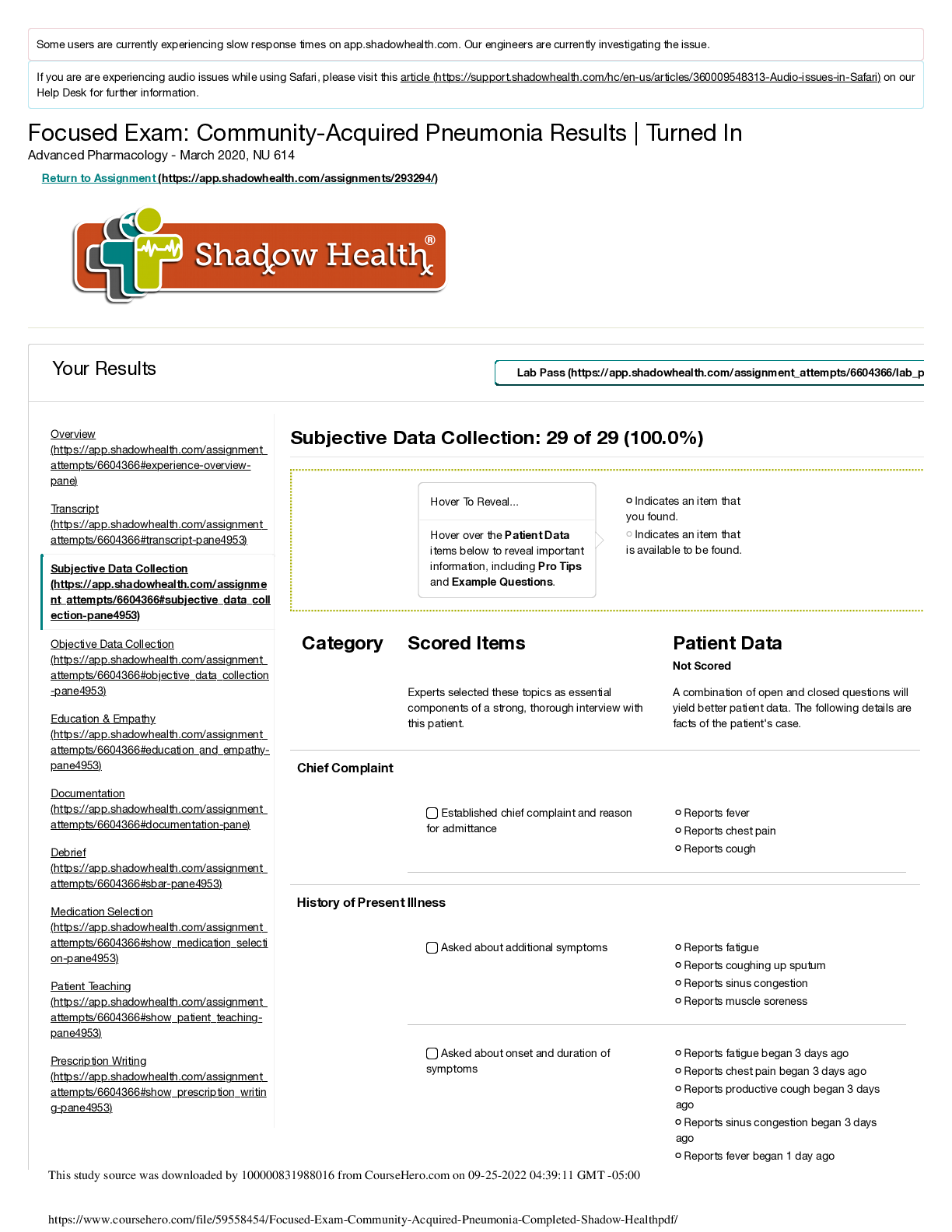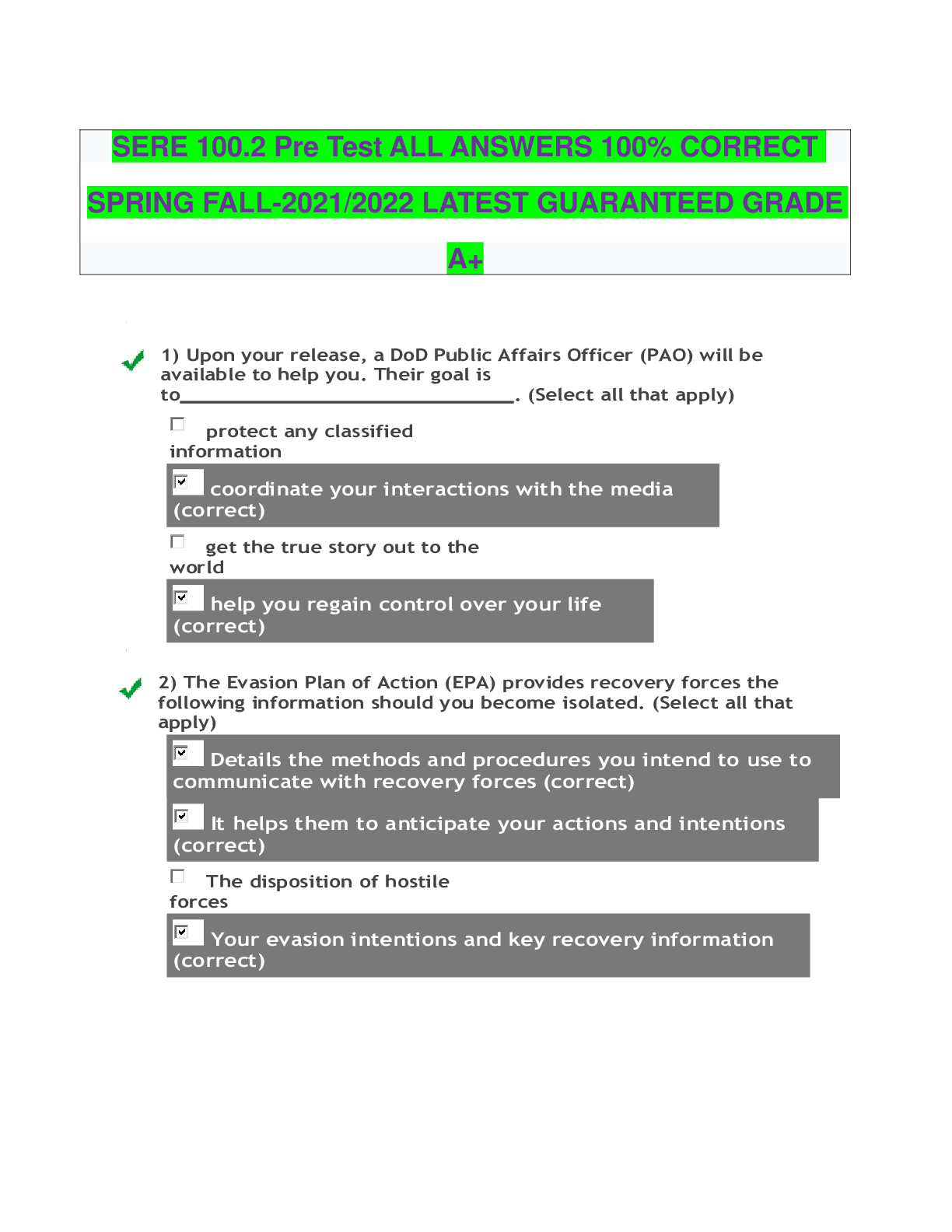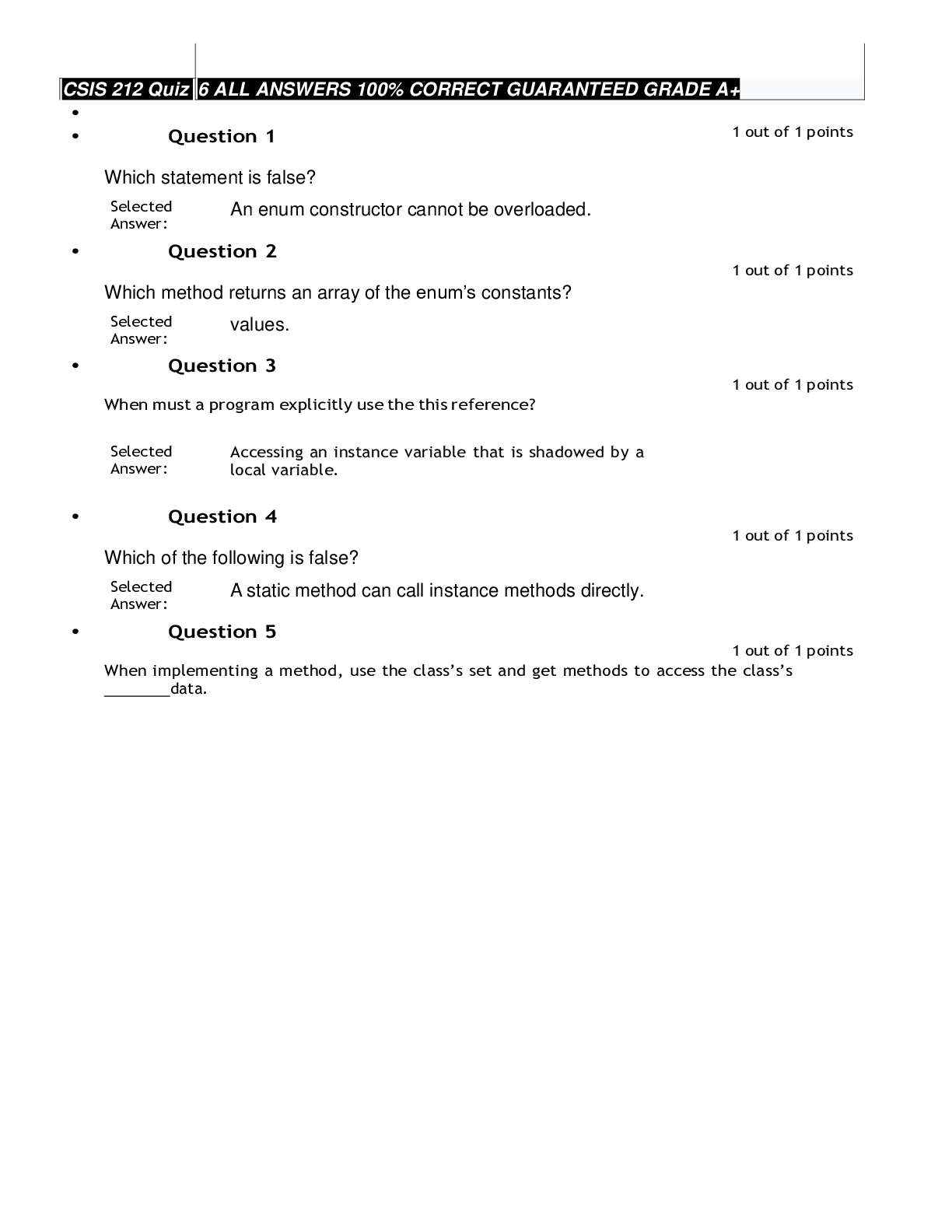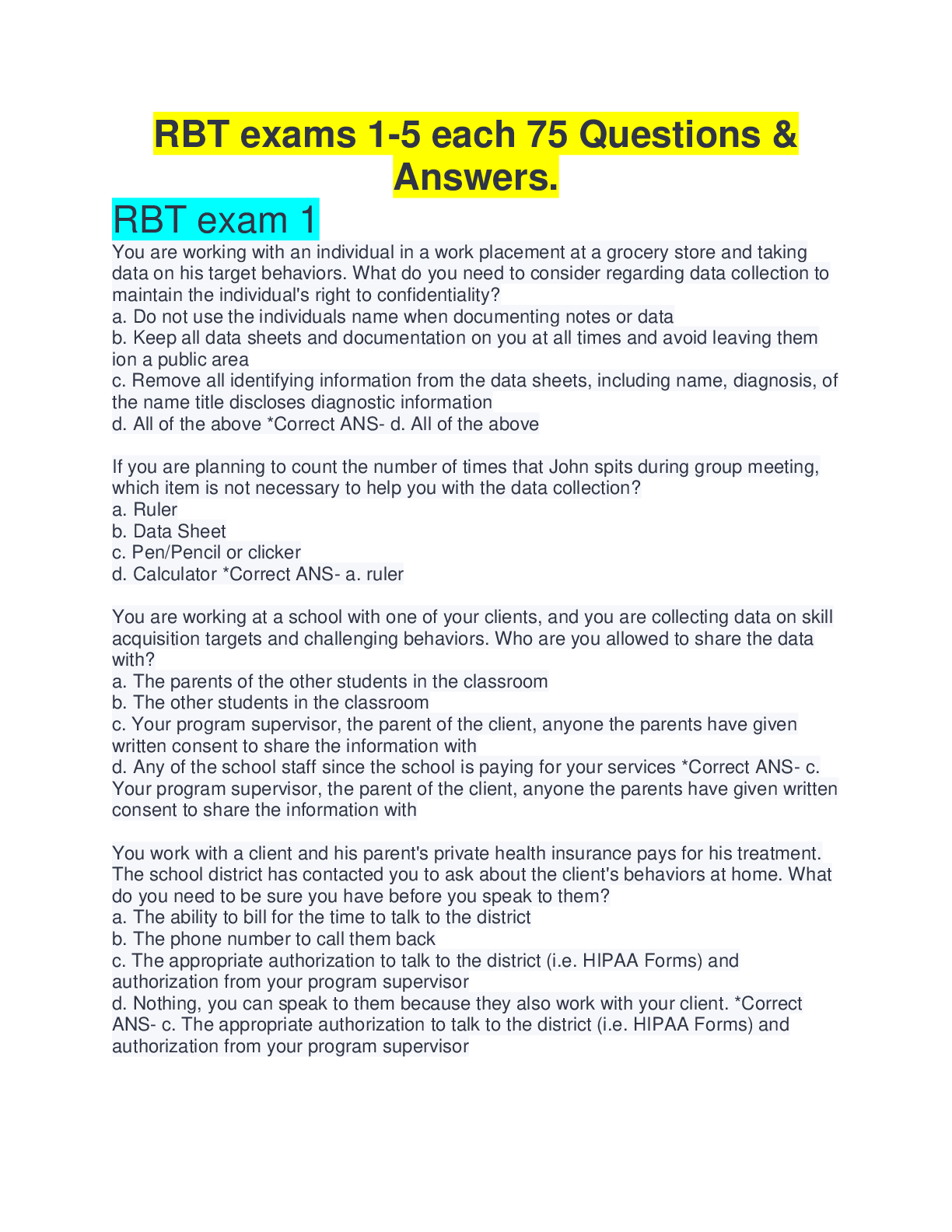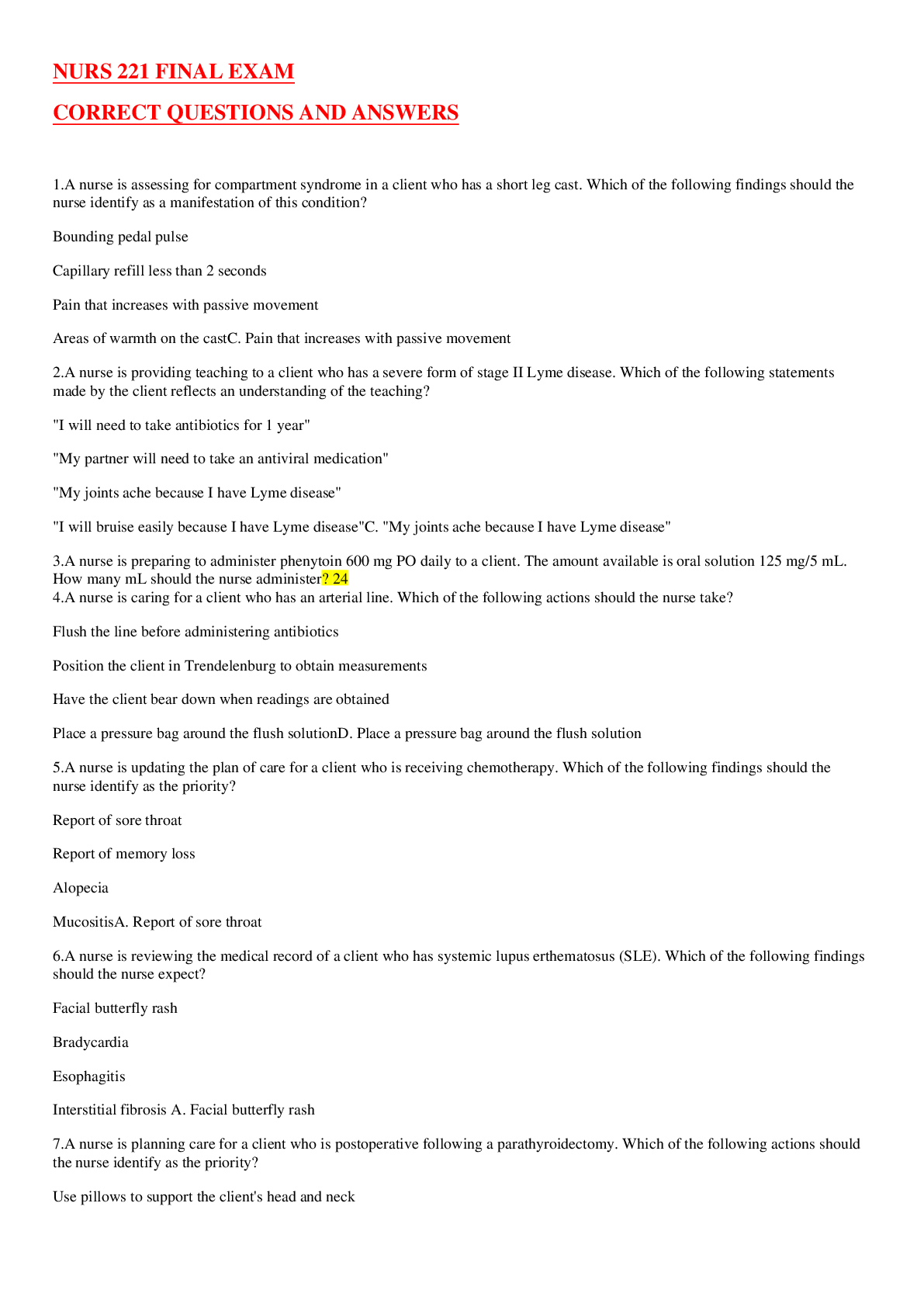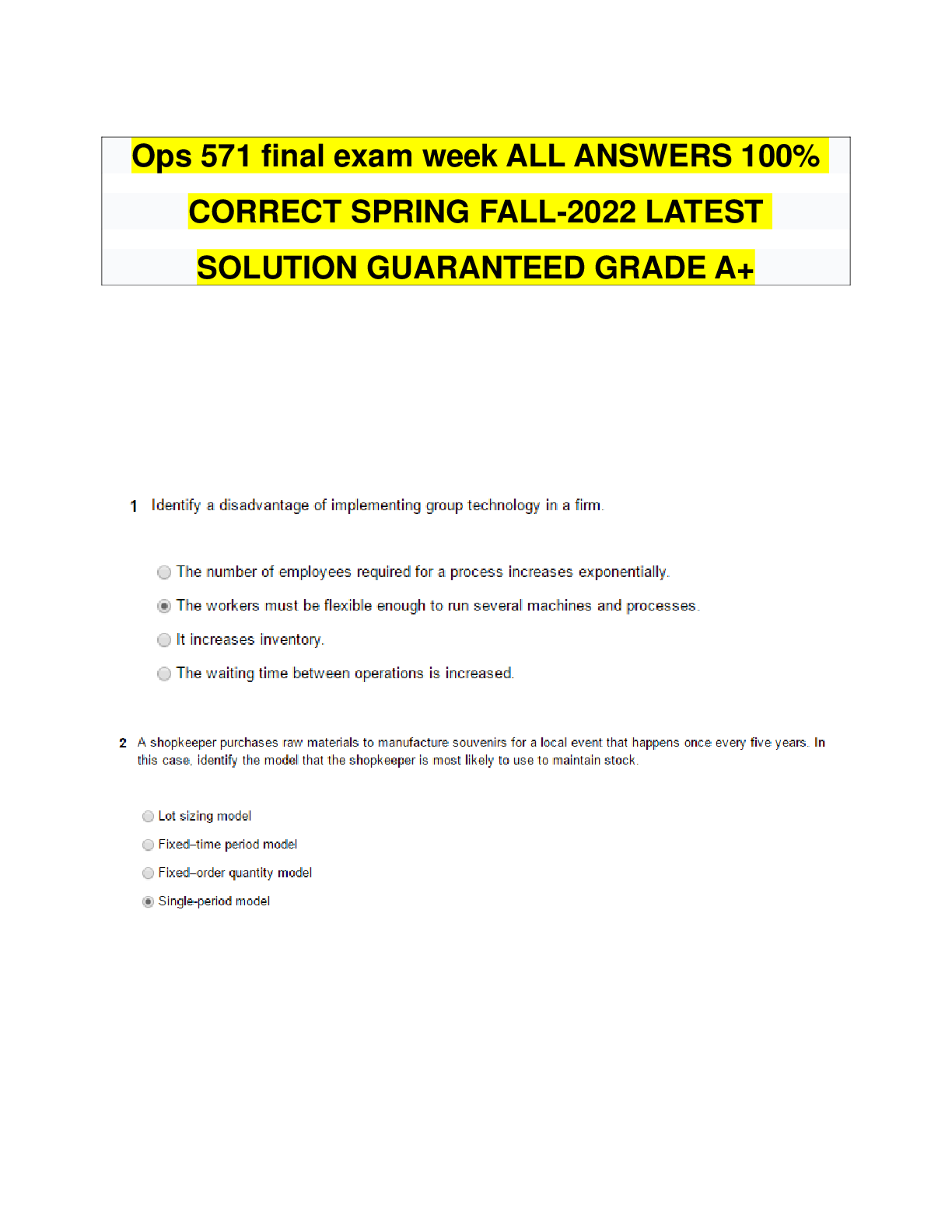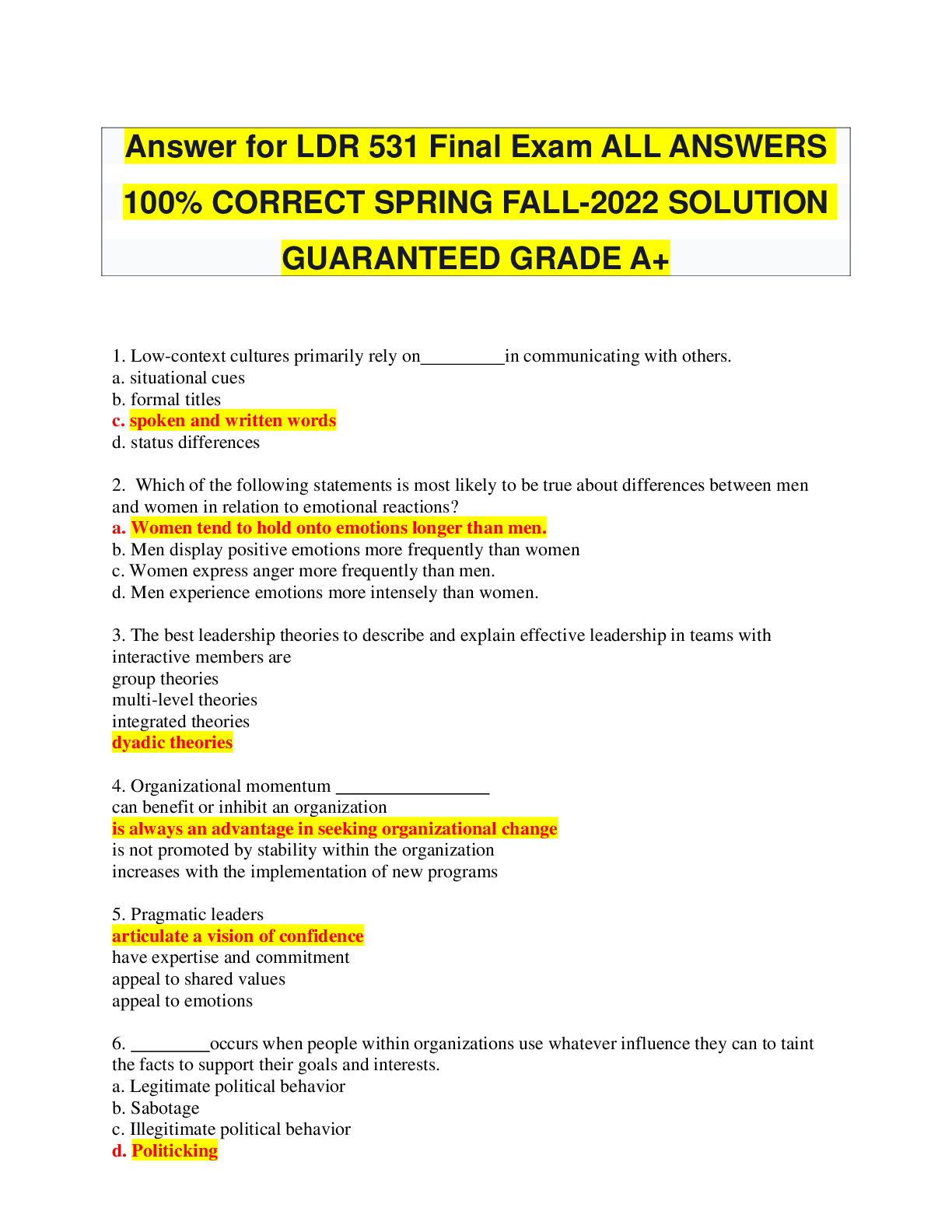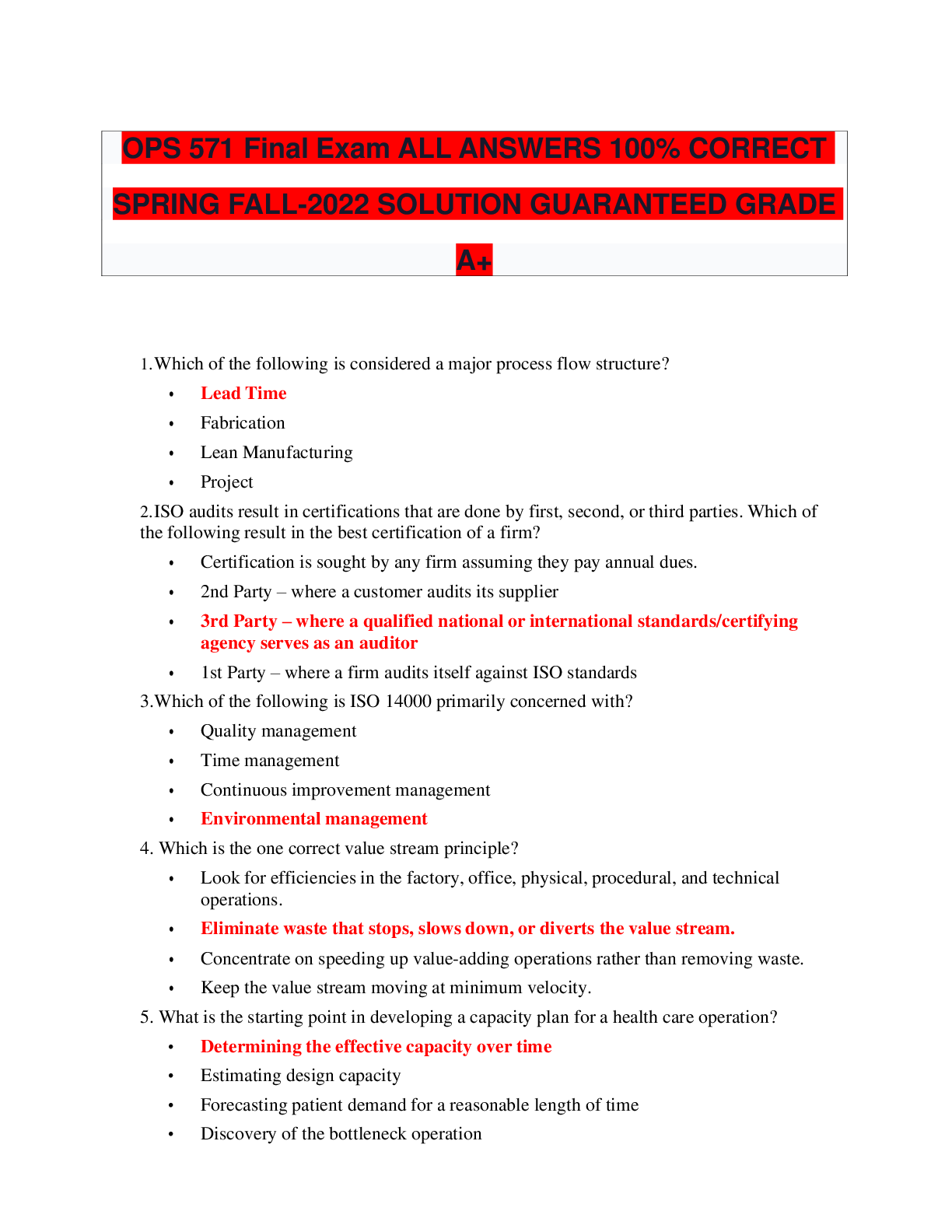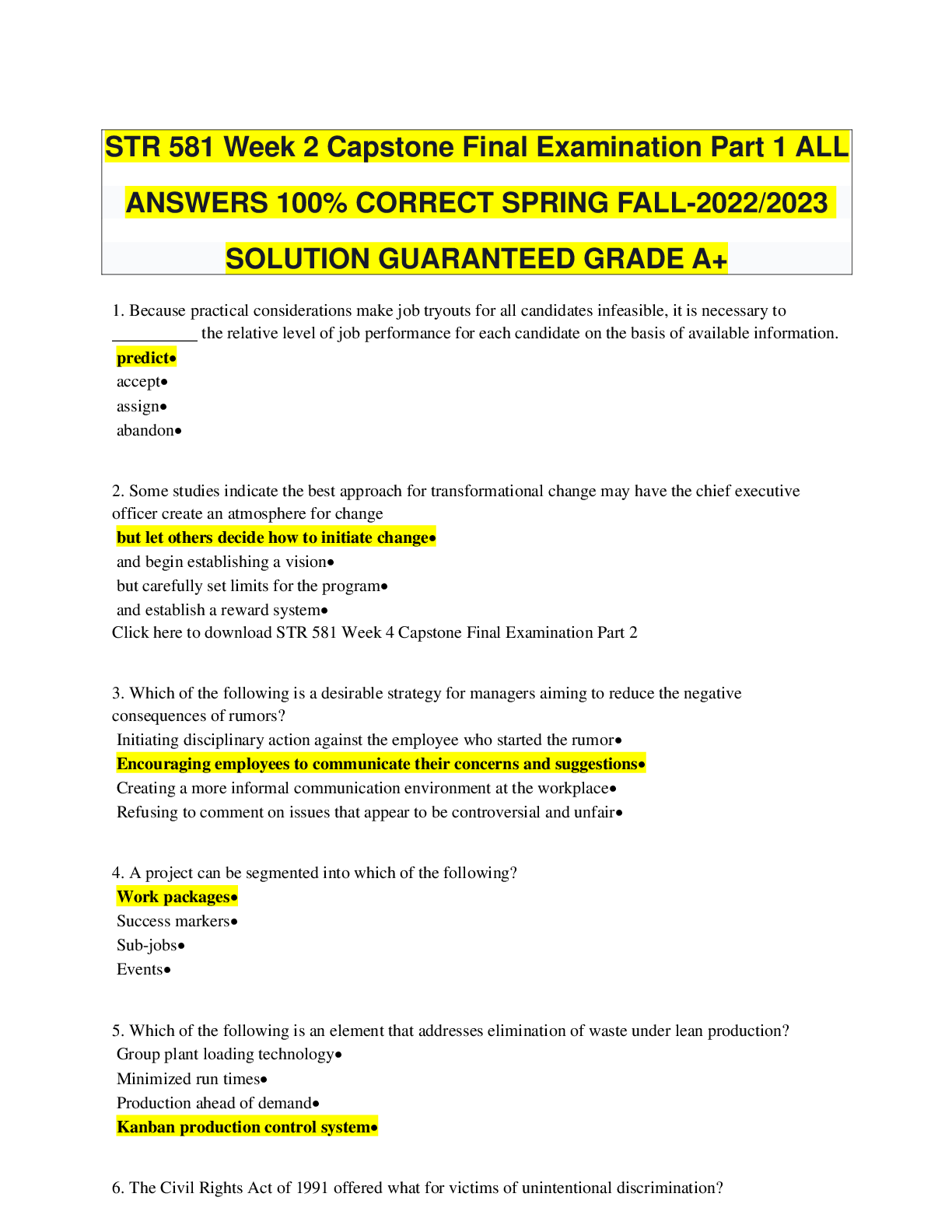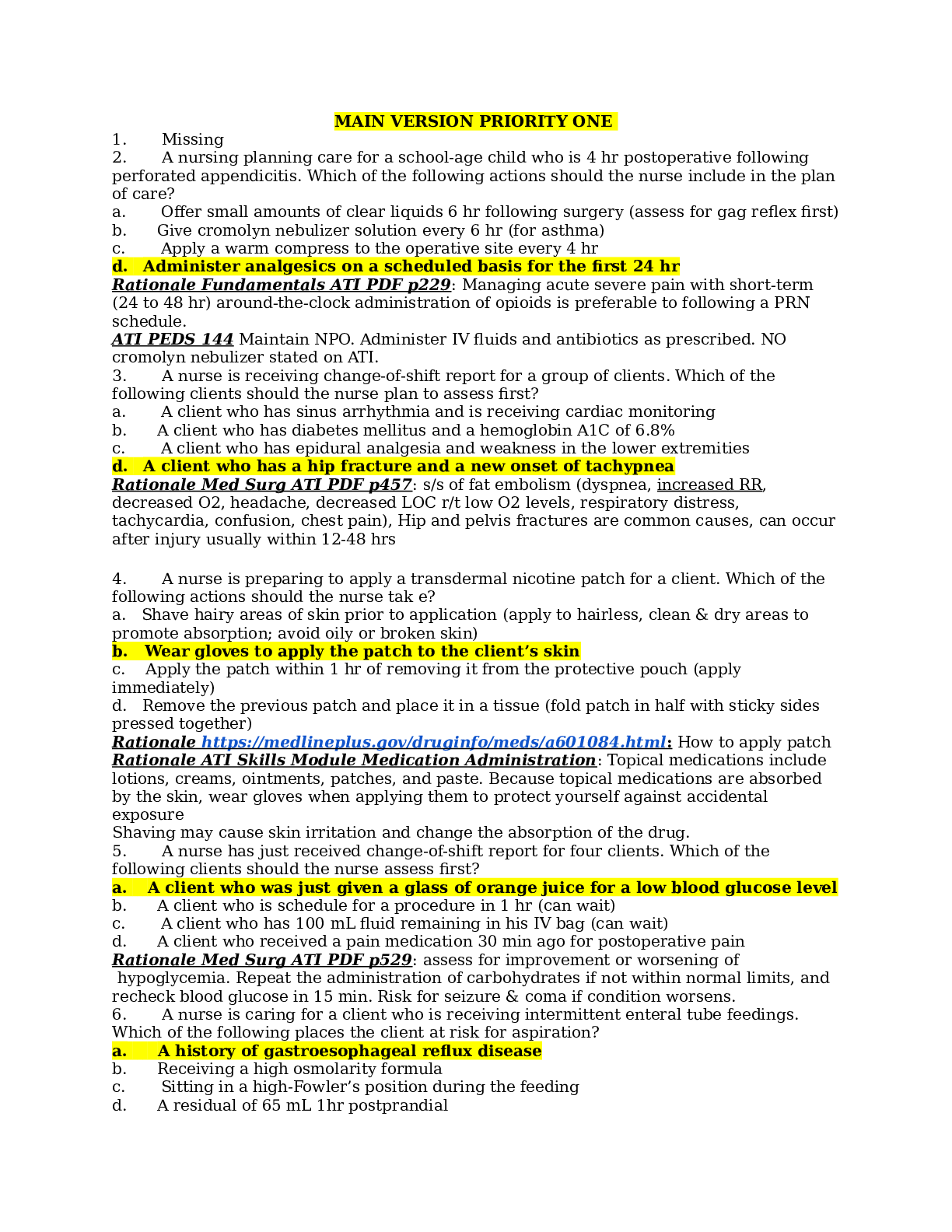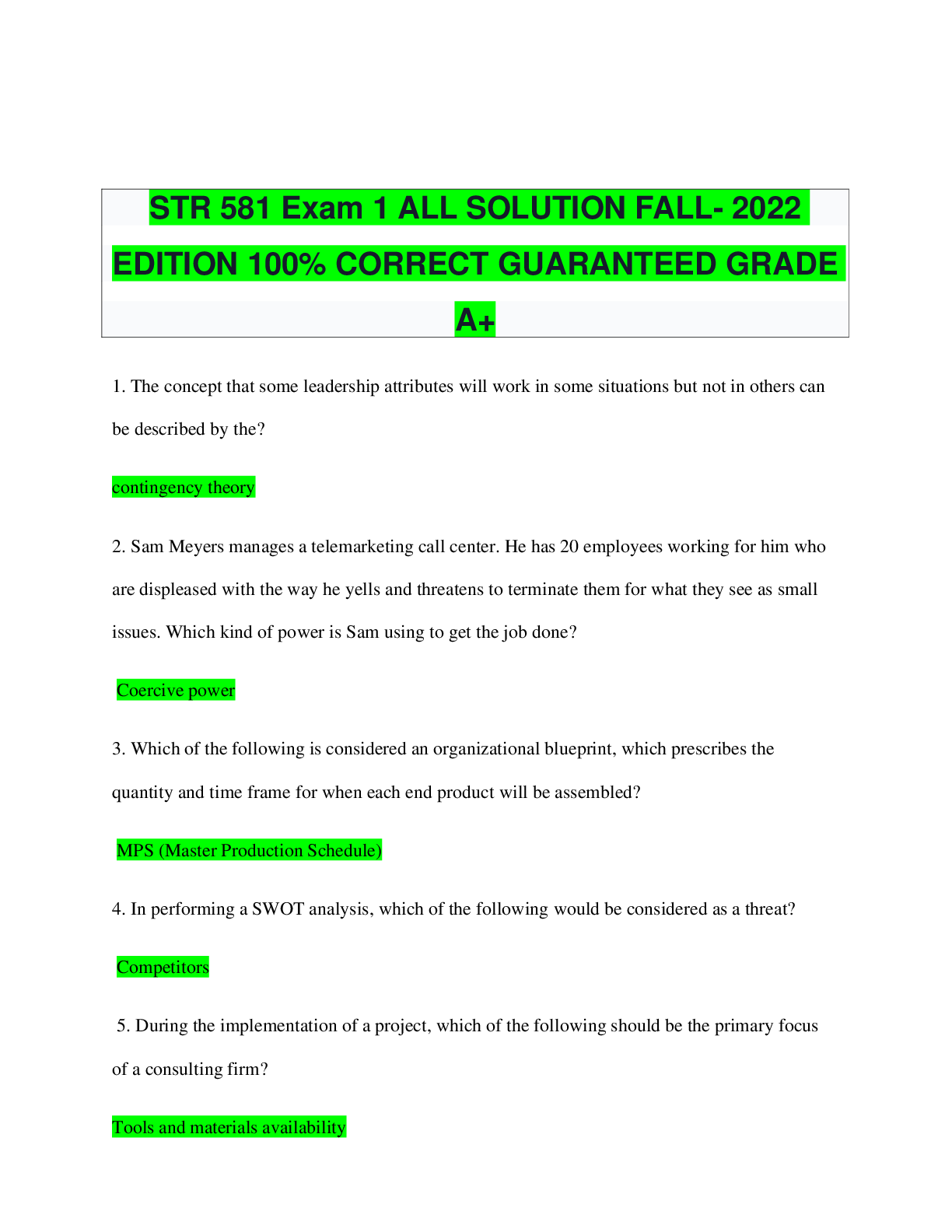*NURSING > EXAM > 3234 Exam 4 Fundamentals Questions & ANSWERS LATEST EDITION 2024 UPDATE GUARANTEED GRADE A+ (All)
3234 Exam 4 Fundamentals Questions & ANSWERS LATEST EDITION 2024 UPDATE GUARANTEED GRADE A+
Document Content and Description Below
Ch 43 #1 A nurse who is assessing an older female patient in a long term care facility notes that the patient is at risk for sensory deprivation related to severe rheumatoid arthritis limiting her act... ivity. Which interventions would the nurse recommend based on this finding. Select al that apply A. use a lower tone when communicating with the patient B. Provide interaction with children and pets C. Decrease environmental noise D. Ensure that the patient shares meals with other patients E. Discourage use of sedatives F. Provide adequate lighting and clear pathways of clutter B, D, E Provide interaction with children and pets, ensure that patient shares meals, and discourage use of sedatives Using lower tone of voice is appropriate for hearing deficit patient, decrease environmental noise is for sensory overload and providing adequate lighting and removing clutter is for vision deficit Ch 43 #2 A nurse is assessing a78 year old male patient for kinesthetic and visceral disturbances. Which techniques would the nurse use for this assessment? Select all that apply. A. nurse asks the patient if he is bored and if so, why B. The nurse asks the patient if anything interferes with the functioning of his senses C. The nurse asks the patient if he noticed any changes in the way he perceives his body D. the nurse asks the patient if he has found it difficult to communicate verbally E. the nurse notes if the patient withdraws from being touched F. The nurse notes if the patient seems unsure of his body parts/position C, D, E, F Kinesthetic and visual disturbances: assess for perceived body changes inside and out, and changes in body parts or position Ch 43 #3 A nurse asks a patient to close her eyes, state when she feels something, and describe the feeling. The nurse then brushes the patient's skin with a cotton ball, and touches the patient's skin with both sides of a safety pin. Which sense is the nurse assessing? A. Gustatory B. Olfactory C. Tactile D. Kinesthetic C Tactile: touch Gustatory: taste Olfactory: smell Kinesthetic: body position Ch 43 #4 A nurse observes that a patient who has cataracts is sitting closer to the TV than usual. The nurse would interpret that the etiologic basis of this sensory problem is an alteration in: A. environmental stimuli B. sensory reception C. nerve impulse conduction D. impulse translation B Cataracts interfere with ability to receive visual stimuli: altered sensory receptoin Ch 43 #5 Which action would be most important for a nurse to include in the plan of care for a patient who is 85 and has prebycusis? A. Obtaining large print written material B. Speaking distinctly, using lower frequencies C. Decreasing tactile stimulation d. Initiating a safety program to prevent falls B Prebycusis: normal loss of hearing as a result of aging process Ch 43 #6 A patient is in the late stages of AIDS, which is now affecting his brain as well as other major organ systems. The patient confides to the nurse that he feels terribly alone because most of his friends are afraid to visit. The nurse determines that the least likely underlying etiology for his sensory problems would be: A. stimulation B. Reception C. tranmission-perception-reaction D. emotional responses D Emotional responses are an effect of sensory deprivation, not the underlying etiology for this condition Receiving decreased environment stimuli from his friends; problems with reception because of major organ involvement; impaired brain function will impair transmisison-perception-reaction Ch 43 #7 Which patient would a nurse assess as being at greatest risk for sensory deprivation? A. an odler man confined to bed at home after a stroke B. an adolescent in an oncology unit working on homework supplied by friends C. A woman in labor D a toddler in a playroom awaiting same day surgery A Ch 43 #8 A patient in an intensive care burn unit for 1 week is in pain much of the time and has his face and both arms heavily bandaged. His wife visits every evening for 15 minutes at 6, 7, and 8pm. A heart monitor beeps for a patient on one side, and another patient moans frequently. Assessment would suggest that the patient probably is experiencing: A. sufficient sensory stimulation B. deficient sensory stimulation C. Excessive sensory stimulation D. both sensory deprivation and overload D Bandages may result in deficient sensory stimulation and the monitors and other sounds in the intensive care burn unit may cause a sensory overload Ch 43 #9 A patient's spinal cord was severed, and he is paralyzed from the waist down. When obtaining data about this patient, which component of the sensory experience would be most important for the nurse to assess? A. transmission of tactile stimuli B. adequate stimulation in the environment C. reception of visual and auditory stimuli D. general orientation and ability to follow commands A Ch 43 #10 A nurse is diagnosing an 11 year old sixth grade student following a physical assessment. The nurse notes that the student's grades have dropped, she has difficulty completing her work on time, and she frequently rubs her eyes and squints. Her visual acuity on the Snellen's eye chart is 160/20. Which nursing diagnosis would be most appropriate? A. Deficient knowledge related to visual impairment B. ineffective role performance related to visual impairment C. disturbed body image related to visual impairment D. delayed growth and development related to visual impairment B Ch 43 #11 A nurse is caring for a male patient with a severe hearing deficit who is able to read lips and use sign language. Which nursing intervention would be best to prevent sensory alterations for this patient? A. Turn the radio or TV volume up very loud and close the door to his room B. Prevent embarrassment and emotional discomfort as much as possible C. Provide daily opportunity for him to participate in a social hour with 6-8 people d. Encourage daily participation in exercise and physical activity C Ch 43 #12 In a group home in which most patients have slight to moderate visual or hearing impairment and some are periodically confused, what would be a nurse's first priority in caring for sensory concerns? A. maintain safety and preventing sensory deterioration B. insisting that every patient participate in as many self care activities as possible C. emphasizing and reinforcing individual patient strengths D. encouraging reminiscence and life review in groups A safety is a basic physiologic need that must be met before higher level needs Ch 43 #13 A nurse formulated the following nursing diagnosis for an 8 month old infant: Disturbed Sensory Perception: Sensory Deprivation related to inadequate parenting. Since that diagnosis was made, both parents have attended parenting classes. However, both parents work while the infant stays with her 86 year old grandmother, who has reduced vision. The parents provide appropriate stimulation in the evening. At an evaluation conference at age 11 months, the infant lies on the floor sucking her thumb and rocking her body. Her facial expression is dull and she vocalizes only in a low monotone. Which statement accurately reflects evaluation about the child's sensory deprivation? A. infant's parents lack motivation to provide necessary stimulation B. grandmother is unable to improve the infant's care C. Infant's sensory deprivation is still severe D. normal behavior for an 11 month old C Parents have been motivated to improve their parenting skills; sensory deprivation is still severe clearly grandmother is not improving the infant's care, but it doesn't mean shes unable to do so Ch 43 #14 A nurse formulates the following diagnosis for an older female patient in a long term care facility: Disturbed Sensory Perception: Chronic Sensory Deprivation related to the effects of aging. The patient walked out the door unobserved and was lost for several hours. Which interventions would be most effective for this patient? Select all that apply A. Ignore when the patient is confused or go along to prevent embarrassment B. Reduce the number and type of stimuli in the patient's room C. Orient the patient to time, place, and person frequently. D. Provide daily contact with children, community people, and pets E. Decrease background or loud noises in the environment F. Provide a radio and TV in the patient's room C, D, F reduce type of stimuli in room and decrease environmental noise is appropriate for a patient who is experiencing sensory overload Ch 43 #15 An older female patient has a severe visual deficit related to glaucoma. Which nursing action would be appropriate when providing care for this patient? A. Assist the patient to ambulate by walking slightly behind the person and grasping the patient's arm B. Concentrate on a sense of sight and limit diversions that involve other senses C. Stay outside of the patient's field of vision when performing personal hygiene for the patient D. Indicate to the patient when the conversation has ended and when the nurse is leaving the room D walk slightly ahead of the person and allow them to grasp nurse's arm, provide diversions using other senses, stay in person's field of vision Ch 39 #1 A nurse is caring for an older patient with T2D who is living in a long term care facility. The nurse determines that the patient's fluid intake and output is approximately 1200mL daily. What patient teachings would the nurse provide for this patient? Select all that apply A. Try to drink at least 6-8 glasses of water each day B. Try to limit your fluid intake to one quart of water daily C. Limit sugar, salt, and alcohol in your diet D. Report side effects of medications you are taking, esp. diarrhea E. Temporarily increase foods containing caffeine for their diuretic effect F. Weigh yourself daily and report any changes in your weight A, C, D, F fluid I/O should be 2600 per day drink more water, maintain normal body weight, avoid consuming excess amounts of products high in salt, sugar, and caffeine, limit alcohol intake, monitor SE of meds Ch 39 #2 A nurse is performing a physical assessment of a patient who is experiencing fluid volume excess. Upon examination of the patient's legs, the nurse documents: "pitting edema, 6mm pit, pit remains several seconds after pressing with obvious skin swelling". What grade of edema has this nurse documented? A. 1+ pitting edema B. 2+ pitting edema C. 3+ pitting edema D. 4+ pitting edema C 1+ slight indentation, normal contour, interstitial fluid volume 30% above normal 2+: 4mm pit that lasts longer than 1+ with fairly normal contour 3+: deep pit, remains seconds after pressing with skin swelling obvious 4+: deep pit that remains for a prolonged time after pressing with frank swelling Ch 39 #3 A nurse is preparing an IV solution for a patient who has hyper-natremia. Which solutions are the best choices for this condition? Select all that apply. a. 5% dextrose in water B. .9% NaCl C. Lactated ringers D. .33% NaCl E. .45% NaCl F. 10% dextrose in water A, D, E .9%NaCl is used to treat hypovolemia, metabolic alkalosis, hyponatremia, hypochloremia Lactated Ringer's: treat hypovolemia, burns, fluid loss from GI intestinal sources 10% dextrose in water: peripheral parenteral nutrition Ch 39 #4 A nurse is assessing infants in the NICU for fluid balance status. Which nursing action would the nurse depend on as the most reliable indicator of a patient's fluid balance status? A. recording intake and output B. testing skin turgor C. reviewing the complete blood count D. measuring weight daily D daily weight is most reliable indicator of a person's fluid balance status Ch 39 #5 Which acid base imbalance would the nurse suspect after assessing the following arterial blood gas values: pH 7.3, PaCO2 36, HCO 14 A. respiratory acidosis B. respiratory alkalosis C. metabolic acidosis D. metabolic alkalosis C low pH: acidosis High pH: alkalosis Low bicarb: metabolic Low PaCO2: respiratory Ch 39 #6 A patient has been encouraged to increase fluid intake. Which measure would be most effective for the nurse to implement? A. Explaining the mechanism involved in transporting fluids to and from intracellular compartments B. keeping fluids readily available for the patient C. emphasizing the long term outcome of increasing fluids when the patient returns home D. planning to offer most daily fluids in the evening B Ch 39 #7 A nurse is caring for a patient who has fluid imbalance related to the development of ascites. Which imbalances would the nurse monitor for in this patient? Select all that apply A. ECF volume deficit B. protein deficit C. metabolic alkalosis D. sodium deficit E. plasma to interstitial fluid shift F. metabolic acidosis A, B, D, E Patients with fluid loss due to ascites are at risk for ECF volume deficit, protein deficit, sodium deficit, and plasma-interstitial fluid shift Ch 39 #8 A nurse is monitoring a patient who is receiving an IV infusion of normal saline. The patient is apprehensive and presents with a pounding headache, rapid pulse rate, chills, and dyspnea. What would be the nurse's priority interventions relate to theses symptoms? A. discontinue the infusion immediately, monitor vital signs, report findings to primary care provider immediately B. slow the rate of infusion, notify the primary care provider immediately and monitor vital signs C. pinch off the catheter or secure the system to prevent entry of air, place the patient in the Trendelenburg position and call for assistance D. Discontinue the infusion immediately, apply warm, moist compresses to the site, and restart the IV at another site A signs and symptoms of speed shock body's reaction to a substance that is injected into the circulatory system too rapidly discontinue infusion, report symptoms of speed shock to primary care provider, monitor vital signs once signs develop B is for fluid overload C is for air embolus D is for phlebitis Ch 39 #9 A nurse carefully assesses the acid-base balance of a patient who is unable to effectively control his carbonic acid supply. This is most likely a patient with damage to which of the following? A. kidneys B. lungs C. adrenal glands D. blood vessels B Lungs: primary controller of body's carbonic acid supply, can affect acid base balance Kidneys: primary controller of body's bicarb supply Adrenal gland: secrete catecholamines, steroid hormones Blood vessels: act only as a transport system Ch 39 #10 A nurse is monitoring a patient who is diagnosed with hypokalemia. Which nursing intervention would be appropriate for this patient? A. encourage foods and fluids with high sodium content B. administe oral K supplements as ordered C. Caution the patient about eating foods high in potassium content D. Discuss calcium losing aspects of nicotine and alcohol use B Ch 39 #11 A nurse is administering 500mL of saline solution to a patient over 10 hours. The administration set delivers 60 gtts/min. Determine the infusion rate to administer via gravity infusion. 50gtts/min gtt/min= (500 x 60) / 600 Ch 39 #12 A nurse is initiating a peripheral venous access IV infusion for a patient. Following the procedure, the nurse observes that the fluid does not flow easily into the vein and the skin around the insertion site is edematous and cool to the touch. What would be the nurse's next action related to these findings? A. reposition the extremity and raise the height of the IV pole B. apply pressure to the dressing on the IV C. pull the catheter out slightly and reinsert it D. put on gloves, remove catheter, apply pressure with sterile pad D IV has been infiltrated. Nurse should put on gloves and remove the catheter. Apply pressure with sterile gauze pad, secure with tape, restart the IV in a new location Ch 39 #13 When monitoring an IV site and infusion, a nurse notes pain at the access site with erythema and edema. What grade of phlebitis would the nurse document? A. 1 B. 2 C. 3 D. 4 B Grade 1 phlebitis: erythema at access site with/without pain Grade 2 phlebitis presents with pain at access site with erythema and edema Grade 3: grade 2 with streak formation and palpable venous cord Grade 4: presents as grade 3 with palpable venous cord > 1 inch and purulent drainage Ch 39 #14 A nurse is administering a blood transfusion for a patient following surgery. During the transfusion, the patient displays signs of dyspnea, dry cough, and pulmonary edema. What would be the nurse's priority actions related to these symptoms? A. slow or stop the infusion; monitor vital signs, notify the physician, place the patient in upright position with feet dependent B. stop the transfusion immediately and keep the vein open with normal saline, notify the physician stat, administer anti-histamine parenterally as needed C. stop the transfusion immediately and keep the vein open with normal saline, notify the physician, treat symptoms D. stop the infusion immediately, obtain a culture of the patient's blood, monitor vital signs, notify the physician, administer antibiotics stat A signs of circulatory overload: too much blood administered Ch 39 #15 A nurse is flushing the patient's implanted port after administering medications. The nurse observes that the port flushes, but does not have a blood return. What would be the nurse's next action based on these findings? A. Gently push down on the needle and flush it a second time B. Stop flushing and remove the needle; notify primary care provider C. Ask the patient to perform a Valsalva maneuver, change patient position D. close clamp, wait 3 minutes, try flushing the port again C if this doesn't work, then remove needle and re-access with new needle Ch 42 #1 A nurse midwife is assisting a patient to deliver a full-term baby. The patient is firmly committed to natural childbirth and has attended each natural childbirth class in prep for labor and delivery. A C section delivery becomes needed when the fetus shows signs of distress. Inconsolable the patient cries and calls herself a failure as a mother. The nurse notes that the patient is experiencing what type of loss? Select all that apply A. actual B. perceived C. psychological D. anticipatory E. physical F. maturational A, B, C Actual loss: recognized by others as well as person sustaining the loss Perceived loss: experienced by the person but is intangible to others Psychological loss: loss that is felt mentally as opposed to physically Anticipatory loss: one grieves prior to the actual loss Physical loss: loss that is tangible and perceived by others Maturational loss: experienced as a result of natural developmental processes Ch 42 #2 A nurse who cared for a dying patient and his family documents that the family is experiencing a period of mourning. Which behaviors would the nurse expect to see at this stage? Select all A. family arranges for a funeral for their loved one B. family arranges for a memorial scholarship for their loved one C. coroner pronounces the patient's death D. family arranges for hospice E. patient is diagnosed with terminal cancer F. Patients daughter writes a poem expressing her sorrow A, B, F Mourning: period of acceptance of loss and grief, during which the person learns to deal with loss; actions and expression of that grief including funeral and celebration of life, that make up the outward expression of grief Ch 42 #3 A nurse interviews an 82 year old resident of a long term care facility who says that she has never gotten over the death of her son 20 years ago. She reports that her life fell apart after that and she never again felt like herself or was able to enjoy life. What type of grief is this woman experiencing? A. abbreviated B. anticipatory C. dysfunctional D. inhibited C Dysfunctional grief: extends mourning period Ch 42 #4 A home health care nurse has been visiting a patient with AIDS who says "I'm no longer afraid of dying. I think I've made my peace with everyone, and I'm actually ready to move on" This reflects the patient's progress to which stage of death and dying? A. acceptance B. anger c. Bargaining D. denial A [Show More]
Last updated: 3 months ago
Preview 1 out of 26 pages
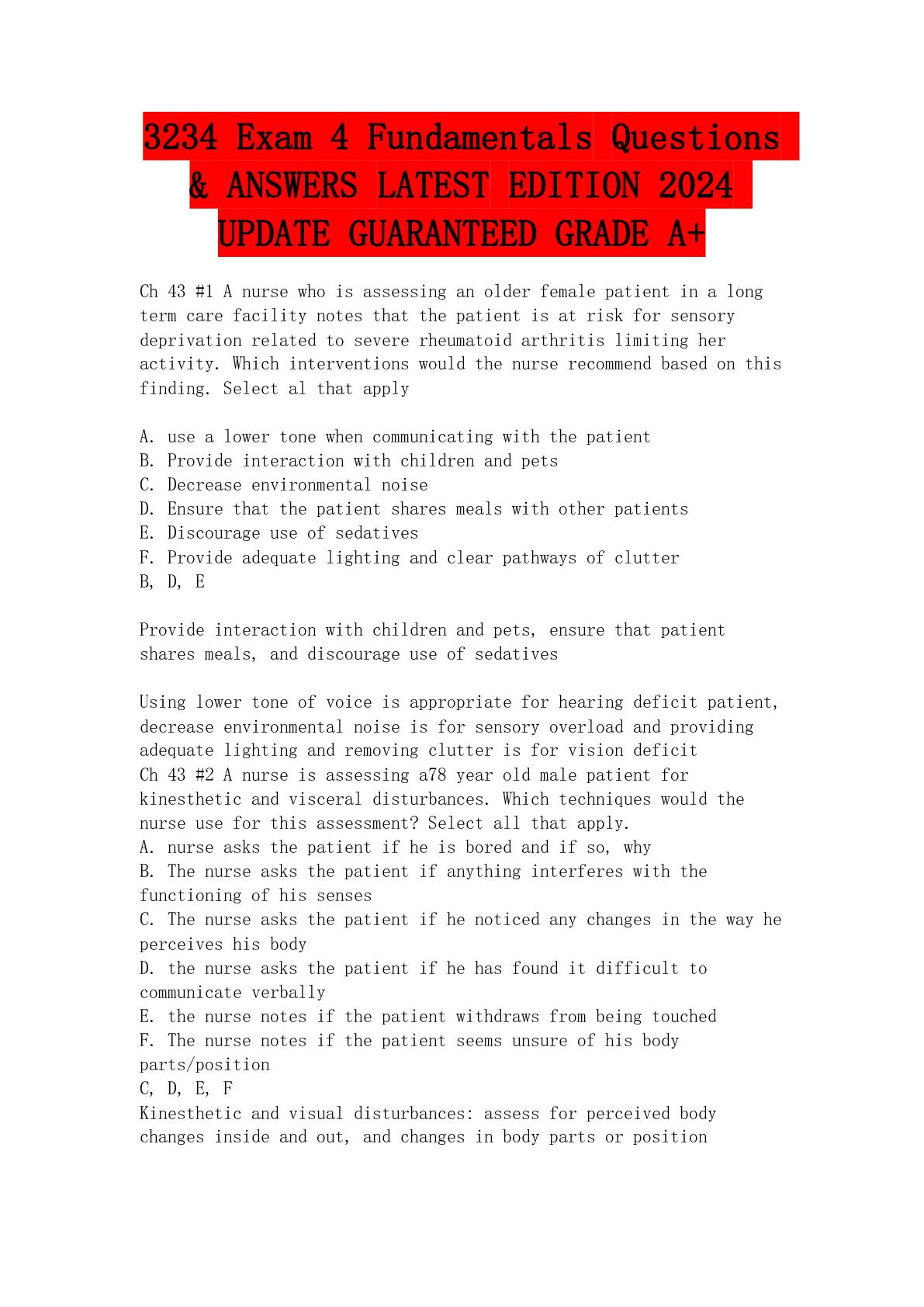
Reviews( 0 )
Document information
Connected school, study & course
About the document
Uploaded On
Jan 16, 2024
Number of pages
26
Written in
Additional information
This document has been written for:
Uploaded
Jan 16, 2024
Downloads
0
Views
10

